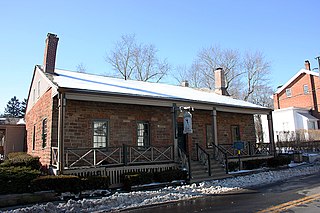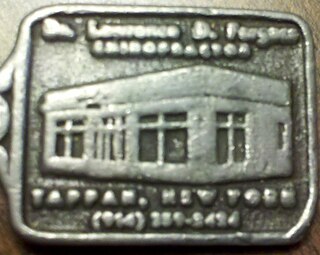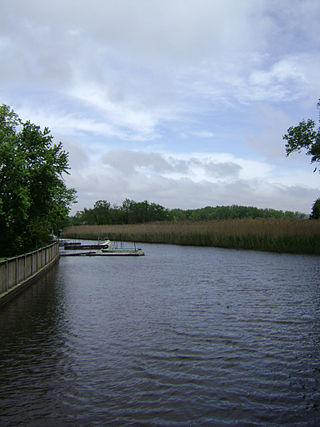
Rockland County is the second-southernmost county on the west side of the Hudson River in the U.S. state of New York, after Richmond County. It is part of the New York metropolitan area. As of the 2020 U.S. census, the county's population is 338,329, making it the state's third-most densely populated county outside New York City after Nassau and neighboring Westchester Counties. The county seat and largest hamlet is New City. Rockland County is accessible via the New York State Thruway, which crosses the Hudson River to Westchester at the Tappan Zee Bridge over the Tappan Zee, ten exits up from the NYC border, as well as the Palisades Parkway five exits up from the George Washington Bridge. The county's name derives from "rocky land", as the area has been aptly described, largely due to the Hudson River Palisades. The county is part of the Hudson Valley region of the state.

New City is a hamlet and census-designated place in the town of Clarkstown, Rockland County, New York, United States, part of the New York Metropolitan Area. An affluent suburb of New York City, the hamlet is located 18 miles (29 km) north of the city at its closest point, Riverdale, Bronx. Within Rockland County, New City is located north of Bardonia, northeast of Nanuet, east of New Square and New Hempstead, south of Garnerville and the village of Haverstraw, and west of Congers. New City's population was 35,101 at the 2020 census, making it the 14th most populous CDP/hamlet in the state of New York.

Nyack is a village located primarily in the town of Orangetown in Rockland County, New York, United States. Incorporated in 1872, it retains a very small western section in Clarkstown. The village had a population of 7,265 as of the 2020 census. It is a suburb of New York City lying approximately 15 miles (24 km) north of the Manhattan boundary near the west bank of the Hudson River, situated north of South Nyack, east of Central Nyack, south of Upper Nyack, and southeast of Valley Cottage.

Orangetown is a town in Rockland County, New York, United States, located in the southeastern part of the county. It is northwest of New York City, north of New Jersey, east of the town of Ramapo, south of the town of Clarkstown, and west of the Hudson River. The population was 48,655 at the 2020 census.

Piermont is a village incorporated in 1847 in Rockland County, New York, United States. Piermont is in the town of Orangetown, located north of the hamlet of Palisades, east of Sparkill, and south of Grand View-on-Hudson, on the west bank of the Hudson River. The population was 2,517 at the 2020 census. Woody Allen set The Purple Rose of Cairo (1984) in Piermont.

South Nyack is a hamlet and census-designated place in the town of Orangetown in Rockland County, New York, United States. It is located north of Grand View-on-Hudson, northeast of Orangeburg, east of Blauvelt State Park, south of Nyack and west of the Hudson River. The hamlet is the western terminus of the Tappan Zee Bridge. Its population was 3,510 at the 2010 census. The hamlet was formerly incorporated as a village from 1878 until 2022.

Tappan is a hamlet and census-designated place in the town of Orangetown, Rockland County, New York. It is located northwest of Alpine, New Jersey, north of Northvale, New Jersey and Rockleigh, New Jersey, northeast of Old Tappan, New Jersey, east/southeast of Nauraushaun and Pearl River, south of Orangeburg, southwest of Sparkill, and west of Palisades; Tappan shares a border with each. The population was 6,673, according to the 2020 census.

Fraunces Tavern is a museum and restaurant in New York City, situated at 54 Pearl Street at the corner of Broad Street in the Financial District of Lower Manhattan. The location played a prominent role in history before, during, and after the American Revolution. At various points in its history, Fraunces Tavern served as a headquarters for George Washington, a venue for peace negotiations with the British, and housing federal offices in the Early Republic.
John Haring was an American lawyer from New York. During his long political career, he was a delegate to the First Continental Congress and Congress of the Confederation, served as president pro tempore of the New York Provincial Congress, served in both the New York State Legislature and New Jersey Legislature, and was a presidential elector.

Blauvelt State Park is a 644-acre (2.61 km2) undeveloped state park located in the Town of Orangetown in Rockland County, New York, near the Hudson River Palisades. The park's land occupies the site of the former Camp Bluefields, a rifle range used to train members of the New York National Guard prior to World War I. The park is located south of Nyack.

Palisades, formerly known as Sneden's Landing, is a hamlet in the Town of Orangetown in Rockland County, New York. It is located north of Rockleigh and Alpine, New Jersey; east of Tappan; south of Sparkill; and west of the Hudson River.

The DeWint House, in Tappan, New York, is one of the oldest surviving structures in Rockland County and is an outstanding example of Hudson Valley Dutch Colonial architecture. It was built using brick and indigenous stone in 1700 by Daniel DeClark, a Hollander, who emigrated to America in 1676 and bought the land from Native Americans in 1682. The date of construction is marked by glazed bricks incorporated into the façade.

New York State Route 303 (NY 303) is a north–south state highway in eastern Rockland County, New York, in the United States. It begins at the New Jersey state line in the hamlet of Tappan and runs generally northward for 10.92 miles (17.57 km) to an intersection with U.S. Route 9W (US 9W) in Clarkstown. The route has connections to the Palisades Interstate Parkway and the New York State Thruway, the latter carrying Interstate 87 (I-87) and I-287. NY 303 was assigned as part of the 1930 renumbering of state highways in New York, and only minor realignments have occurred since that time.
The Orangetown Resolutions were adopted on July 4, 1774, exactly two years prior to the adoption of the United States Declaration of Independence. The resolutions were part of a widespread movement of town and county protests of the Intolerable Acts passed by the British Parliament in 1774.

The Reformed Church of Tappan in Tappan, Rockland County, New York is a historic church. It is a contributing property to the Tappan Historic District.

The Michael Salyer Stone House is located on Blue Hill Road in Orangetown, New York, United States. It was built in the late 18th century.

Tappan Historic District is a national historic district located at Tappan in Rockland County, New York. It encompasses 26 contributing buildings and three contributing sites. The district consists of 30 properties that reflect the historic commercial and residential core of the late 18th and 19th century village of Tappan. The Reformed Church of Tappan, The Old 76 House, Borcher's Stable and The Burton Store are located within the district boundaries.
The recorded history of Rockland County, New York begins on February 23, 1798, when the county was split off from Orange County, New York and formed as its own administrative division of the state of New York. It is located 6 miles (9.7 km) north-northwest of New York City, and is part of the New York Metropolitan Area. The county seat is the hamlet of New City. The name comes from rocky land, an early description of the area given by settlers. Rockland is New York's southernmost county west of the Hudson River. It is suburban in nature, with a considerable amount of scenic designated parkland. Rockland County does not border any of the New York City boroughs, but is only 9.5 miles (15.3 km) north of Manhattan at the counties' two respective closest points

The Burton Store is a historic building in Tappan, New York, located within the bounds of the Tappan Historic District. Once functioning as Tappan's general store, it has been occupied since 1985 by chiropractor Lawrence Forgacs' Tappan Professional Center. The Burton Store is one of two buildings in the district constructed in the Colonial Revival style, the other being the nearby Borcher's Stable, located at 2 Oak Tree Road just beyond The Old 76 House. This was the last building phase during the period of significance in the early twentieth century as recognized by the Tappan Historic District. It is located adjacent to The Old 76 House and across the street from The Manse Barn. The Burton Store is described by Alicia A. Jettner in the National Register of Historic Places as follows:

Sparkill Creek, is a tributary of the Hudson River in Rockland County, New York and Bergen County, New Jersey in the United States. It flows through the Sparkill Gap in the Hudson Palisades, which was created by a fault line which provided the only sea-level break in the Palisades.




















